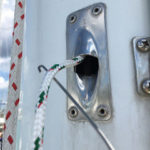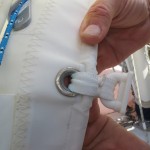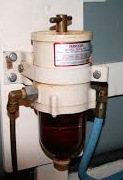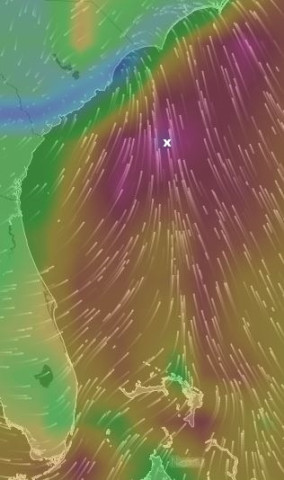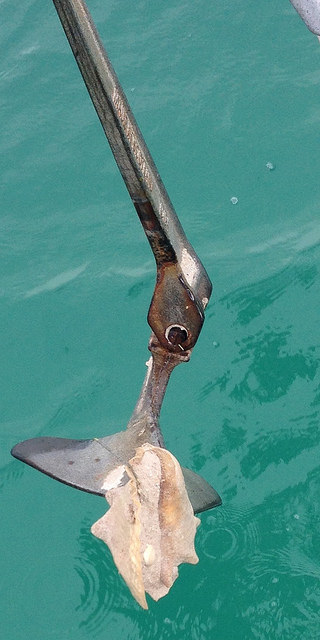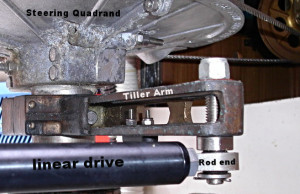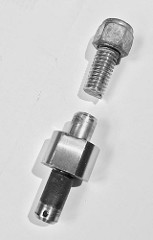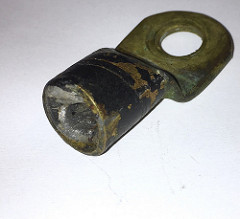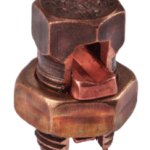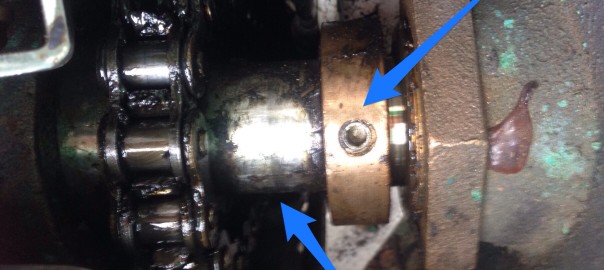The easier method is to whip the two ends together – new to old, and haul away on the old halyard until the new rope takes its place. 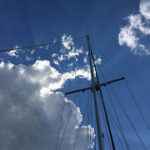
The existing halyard was AWOL however, sheared due to chafe when the mainsail failed and flogged, so a raw procedure was required using gravity. Climbing 50′ above deck to the masthead with the new cordage takes some preparation for planning. Have the necessary items with you as you arrive at the top because it does involve physical effort to ascend and descend. It would be good to only have to make one safe roundtrip.
The 1/2″ (12mm) X 150′ Braided Rope replacement, while quite flexible, is a bit unwieldy so a much smaller lead line was attached to a spliced end to guide the big rope over the sheave at the 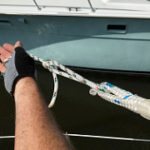
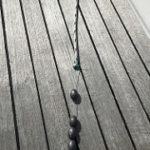 masthead and down through the hollow interior of the mast itself and then out the shield plate exit at its base. This lead line is light in weight so to keep it straight and true for its descent, a length of nylon fishing line with small lead weights was fashioned. This was probably overkill. 50′ of fishing line might have done the job ( but I imagined that I would arrive at mast peak with a snarled mess of knots to sort). The biggest challenge as it turns out was passing the lead weights over the sheave within the confines of the mast head. There was scarce wiggle room for line , mass of weights, and one finger to poke, prod, cajole, through the narrow passage. The weights tended to rear up straight falling backwards over the top of themselves. I needed them to fold over the arch of the sheave and head downward. Finally, after many failed tries and with the insertion of a second finger to manually spin the sheave I was able to finesse the lot inward and onward.
masthead and down through the hollow interior of the mast itself and then out the shield plate exit at its base. This lead line is light in weight so to keep it straight and true for its descent, a length of nylon fishing line with small lead weights was fashioned. This was probably overkill. 50′ of fishing line might have done the job ( but I imagined that I would arrive at mast peak with a snarled mess of knots to sort). The biggest challenge as it turns out was passing the lead weights over the sheave within the confines of the mast head. There was scarce wiggle room for line , mass of weights, and one finger to poke, prod, cajole, through the narrow passage. The weights tended to rear up straight falling backwards over the top of themselves. I needed them to fold over the arch of the sheave and head downward. Finally, after many failed tries and with the insertion of a second finger to manually spin the sheave I was able to finesse the lot inward and onward.
The next task was to temporarily secure the lead line at the top. 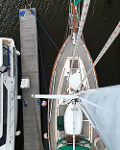 Our friend Gravity, while assisting the placement of the feeder line would be just as happy to pull it all back down again once I turned loose of it. There was an elegant idea to use lightweight masking tape. It would have torn away freeing the line after a moderate tug. An excellent solution but I lost my roll of tape to the silty bottom of the Marina when it got away from my tool belt. Not wanting to tie a knot, which would necessitate a revisit, I wrapped the exposed free end of the line around the backstay knowing that I could unwrap from below. The friction was enough to stabilize and hold in place as I commenced descent.
Our friend Gravity, while assisting the placement of the feeder line would be just as happy to pull it all back down again once I turned loose of it. There was an elegant idea to use lightweight masking tape. It would have torn away freeing the line after a moderate tug. An excellent solution but I lost my roll of tape to the silty bottom of the Marina when it got away from my tool belt. Not wanting to tie a knot, which would necessitate a revisit, I wrapped the exposed free end of the line around the backstay knowing that I could unwrap from below. The friction was enough to stabilize and hold in place as I commenced descent.
Finally a slim hook was used to probe the hollow spaces and the leader fished out of the mast at deck level. The Ahhhh moment was grasping the spliced end of the new halyard and knowing in the success of the moment. 